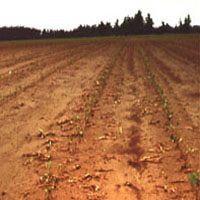What should I do about hail damaged cotton stands?
 Every year some fields are hit by hail. The replanting statements in Should I replant? apply to hail-damaged cotton as well. Deciding what to do with a field of cotton after a hail is often a difficult decision. When looking in a hail-damaged field, examine the plants to see what percent have a terminal, what percent do not have a terminal, and what percent are cut off below the cotyledon node. Those cut off below the cotyledon node will probably not recover. Those that do not have a terminal will probably recover but produce a crazy plant with many branches. These plants can produce cotton but will mature late and be subjected to the problems associated with late cotton, i.e., insects, weather, and increased production cost with low potential returns. In other words, the risks are great
Every year some fields are hit by hail. The replanting statements in Should I replant? apply to hail-damaged cotton as well. Deciding what to do with a field of cotton after a hail is often a difficult decision. When looking in a hail-damaged field, examine the plants to see what percent have a terminal, what percent do not have a terminal, and what percent are cut off below the cotyledon node. Those cut off below the cotyledon node will probably not recover. Those that do not have a terminal will probably recover but produce a crazy plant with many branches. These plants can produce cotton but will mature late and be subjected to the problems associated with late cotton, i.e., insects, weather, and increased production cost with low potential returns. In other words, the risks are great
Examine the stems of seedlings that survive. Stem damage may be severe enough to cause lodging later in the season. As the season progresses, additional considerations include the following: How "strong" is the soil? Where in the state is the field located, north or south? What is the variety in the field?
If the date is after the first of June and the number of plants that are damaged to a degree such as to make survival unlikely is go great that the plant population will be below 20,000 plants per acre with numerous skips, destroying the stand may be in order. If the survivable plant population is greater than 20,000 plants per acre, and the stand is uniform I would keep it. Plants with damaged terminal will produce vegetative branches which will set fruit. Maturity will be delayed and management must be adjusted for a late crop.
 If the weather turns favorable after a hail storm event, plant recovery will be phenomenal. One of the reasons for this is that the root:shoot ratio has changed tremendously. The plant should have the same size root system after the hail storm event as it did before. However, the shoot, or leaf area, will be greatly reduced.
If the weather turns favorable after a hail storm event, plant recovery will be phenomenal. One of the reasons for this is that the root:shoot ratio has changed tremendously. The plant should have the same size root system after the hail storm event as it did before. However, the shoot, or leaf area, will be greatly reduced.
The fact that the leaf area is reduced and injured is one of the reasons why attempting to foliar feed hail damaged cotton has not been successful.
There are no miracle cures that can be sprayed on the fields to increase survival or yields. Make replant decisions carefully.
The very thing that makes cotton so complicated to manage, being an indeterminate perennial, gives cotton an advantage over other crops when hit by hail. Cotton can recover much better from hail damage than soybeans, and especially corn.
If there is a doubt, keep it. Cotton can really come back.
When examining a hail-damaged field examine the plants to see what percent have a terminal, what percent do not have a terminal and what percent are cut off below the cotyledon node. Those cut off below the cotyledon node will probably not recover. Those that do not have a terminal will probably recover but produce a crazy plant with many branches. These plants can produce cotton but will mature very late and thus be subjected to the problems associated with late cotton, i.e. insects and weather. Examine the stems of those seedlings which may survive. Stem damage may be severe enough to cause lodging later in the season.
After a hail, avoid going into the field for several days. Cotton will look terrible the day after hail event. Give the cotton some time to recover before herbicides are applied.
Hail damaged cotton will produce numerous vegetative branches. Hail damaged fields will also act like and need to be treated like "late cotton." The only plant growth regulator we have had much success with in late cotton is mepaquat chloride (PIX, ect). For this reason hail damaged cotton has a good potential to respond to PIX application. These applications should be made after the cotton has recovered and branching and setting fruit. If you have specific questions about manageing hail damaged cotton, call your local county agent.
Publications
News
STARKVILLE, Miss. -- Row crop producers who reported financial loss in 2024 may be eligible for economic assistance through a U.S. Department of Agriculture resource.
STARKVILLE, Miss. -- Row crop growers in Mississippi expect to plant more corn in 2025 than they did last year, but not as much cotton or as many soybeans.
STARKVILLE, Miss.



